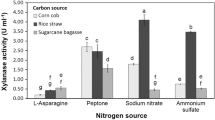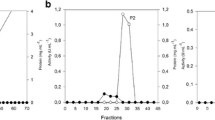Abstract
Liquefaction of dry and freshPalmaria palmata by food grade enzyme preparations and a purified endo-β-1,4-D-xylanase was studied.
The endo-β-1,4-D-xylanase (EC 3.2.1.8) was purified to homogeneity from a commercial food grade enzyme prepared fromAspergillus niger. It has a molecular weight of 22 500, a pI of 3.5, is inactive toward corn arabinoxylan,p-nitrophenyl-β-D-xylose, carboxymethyl cellulose but shows a weak activity toward microcrystalline cellulose. It hydrolyzes oat and dulse xylan equally well in seawater and deionized water essentially into xylose and xylobiose. It is stable between pH 5.5 to 9.0 and 0 to 30 °C and its activity is optimal at pH 4.5–5.5 and 40–60 °C. It has a Km of 2.2 and 2.8 mg ml-1 and Vmax of 3600 and 3900 nkat mg-1 of protein on oat and dulse xylan, respectively.
Acetate buffer, deionized water and seawater alone extracted 62.6 to 64.5 % of the dry weight of dry dulse, but the use of commercial food grade enzyme preparations or the purified xylanase improved liquefaction to 81.2–87.1 %. Xylose and galactose were the only sugars present in the soluble extracts. Deionized and seawater extracted 58.8–52.7 and 39.1–42.2% of the dry weight of the fresh algae collected in fall and summer, respectively. Only galactose was found in the seawater extract, while some xylose with galactose were measured in the deionized water extract of the fresh autumn algal sample. Purified and crude xylanase improved liquefaction of fresh algae to 79.8–81.4 and 71.9–77.9% of the fresh dry weight (fall and summer, respectively) in deionized and seawater, respectively, and increased the xylose content of the soluble fractions. Polysaccharides in the soluble residues were composed of 1,3/1,4-linked xylose, 1-linked galactose (floridoside) and 1,4-linked glucose (cellulose) and contained essentially 1,4-linked xylose and 1,4-linked glucose in insoluble fractions obtained after enzymatic treatment.
The use of xylanase-containing food grade enzyme preparations improves liquefaction ofPalmaria palmata, particularly from fresh alga. This study indicates that processing such as drying may modify markedly the solubility ofP. palmata cell wall polysaccharides, which would imply the existence of some organization and/or other components in the fresh cell wall that lower xylan solubility in seawater.
Similar content being viewed by others
References
Blakeney AB, Harris PJ, Henry RJ, Stone BA (1983) A simple and rapid preparation of alditols acetates for monosaccharide analysis. Carbohydr. Res. 113: 291–299.
Blakeney AB, Stone BA (1985) Methylation of carbohydrates with lithium methylsulfinyl carbanion. Carbohydr. Res. 140: 319–324.
Björndal H, Erikson KE, Garegg PJ, Lindberg B, Swan B (1965) Studies on the xylan from the red seaweedRhodymenia palmata. Acta Chem. Scand. 19: 2309–2315.
Bronnenmeier D, Ebenbichler C, Standenbauer L (1990) Separation of the cellulolytic and xylanolytic enzymes ofClostridium stercorarium. J. Chrom. 521: 301–310.
Dekker RFH, Richards GN (1976) Hemicellulases: their occurence, purification, properties, and mode of action. Adv. Carbohydr. Chem. Biochem. 32: 277–352.
Fournier RA, Frederick MM, Frederick JR, Reilly PJ (1985) Purification and characterization of endo-xylanases fromAspergillus niger. III An enzyme of pI 3.65. Biotechnol. Bioeng. 27: 539–546.
Frederick MM, Frederick JR, Fratzke AR, Reilly PJ (1981) Purification and characterization of a xylobiose- and xylose-producing endo-xylanase fromAspergillus niger. Carbohydr. Res. 97: 87–103.
Frederick MM, Kiang C-H, Frederick JR, Reilly PJ (1985) Purification and characterization of endo-xylanases fromAspergillus niger. I Two isozymes active on xylan backbones near branch points. Biotechnol. Bioeng 27: 525–532.
Harris PJ, Henry RJ, Blakeney AB, Stone BA (1984) An improved procedure for the methylation analysis of oligosaccharides and polysaccharides. Carbohydr. Res. 127: 59–73.
Hoebler C, Barry J-L, David A, Delort-Laval J (1989) Rapid acid hydrolysis of plant cell wallpolysaccharides and simplified quantitative determination of their neutral monosaccharides by gas-liquid chromatography. J. agric. Food Chem. 37: 360–367.
Indergaard M, Minsaas J (1991) Animal and human nutrition. In Guiry MD, Blunden G (eds), Seaweed Resources in Europe: Uses and Potential. John Wiley & Sons, 21–64.
Lahaye M, Michel C, Barry JL (1992) Chemical, physicochemical andin vitro fermentation characteristics of dietary fibres fromPalmaria palmata (L.) Kuntze (dulse). Food Chem. (accepted for publication).
Lahaye M, Vigouroux J, Thibault J-F (1991) Endo-β-1,4-D-galactanase fromAspergillus niger var.aculeatus: Purification and some properties. Carbohydr. Polymers 15: 431–444.
Lowry OH, Rosebrough NJ, Farr AL, Randall RJ (1951) Protein measurement with the Folin phenol reagent. J. biol. Chem. 193: 265–275.
Mabeau S, Cavaloc E, Fleurence J, Lahaye M (1992) New seaweed based ingredients for the food industry. International Food Ingredient June/July: 38–44.
McCleary BV (1986) Enzymatic modification of plant polysaccharides. Int. J. Biol. Macromol. 8: 349–354.
Morgan KC, Wright JLC, Simpson FJ (1980) Review of the chemical constituents of the red algaPalmaria palmata (dulse). Econ. Bot. 34: 27–50.
Nelson N (1944) A photometric adaptation of the Somogyi method for determination of glucose. J. biol. Chem. 153: 375–380.
Percival E, McDowel RH (1967) Chemistry and Enzymology of Marine Algal Polysaccharides. Academic Press, London, U.K., 219 pp.
Rozie H, Somers W, Bonte A, Visser J, Van 't Riet K, Rombouts FM (1988) Adsorption characteristics of endopolygalacturonase on alginate beads. Biotechnol. appl. Biochem. 10: 346–358.
Shei JC, Fratzke AR, Frederick MM, Frederick JR, Reilly PJ (1985) Purification and characterization of endo-xylanases fromAspergillus niger. II An enzyme of pI 4.5. Biotechnol. Bioeng 27: 533–538.
Turvey JR, Williams EL (1970) The structures of some xylans from red algae. Phytochem. 9: 2383–2388.
Author information
Authors and Affiliations
Rights and permissions
About this article
Cite this article
Lahaye, M., Vigouroux, J. Liquefaction of dulse (Palmaria palmata (L.) Kuntze) by a commercial enzyme preparation and a purified endo ,β-1,4-D-xylanase. J Appl Phycol 4, 329–337 (1992). https://doi.org/10.1007/BF02185790
Received:
Revised:
Accepted:
Issue Date:
DOI: https://doi.org/10.1007/BF02185790




